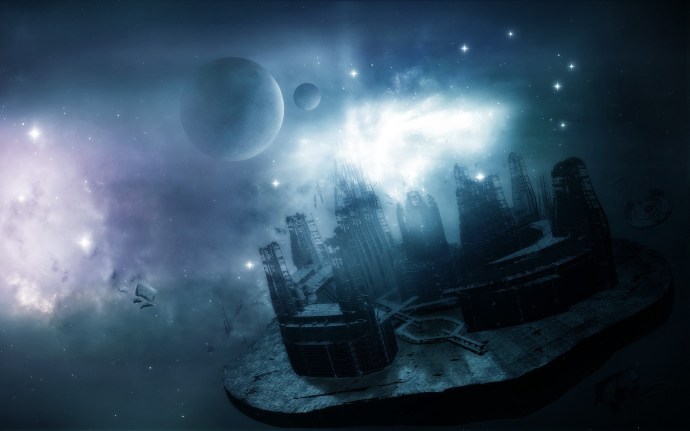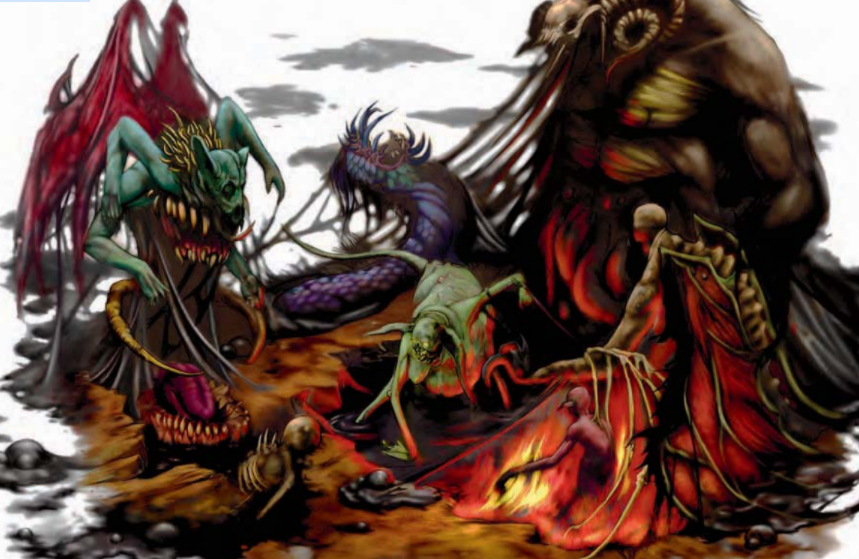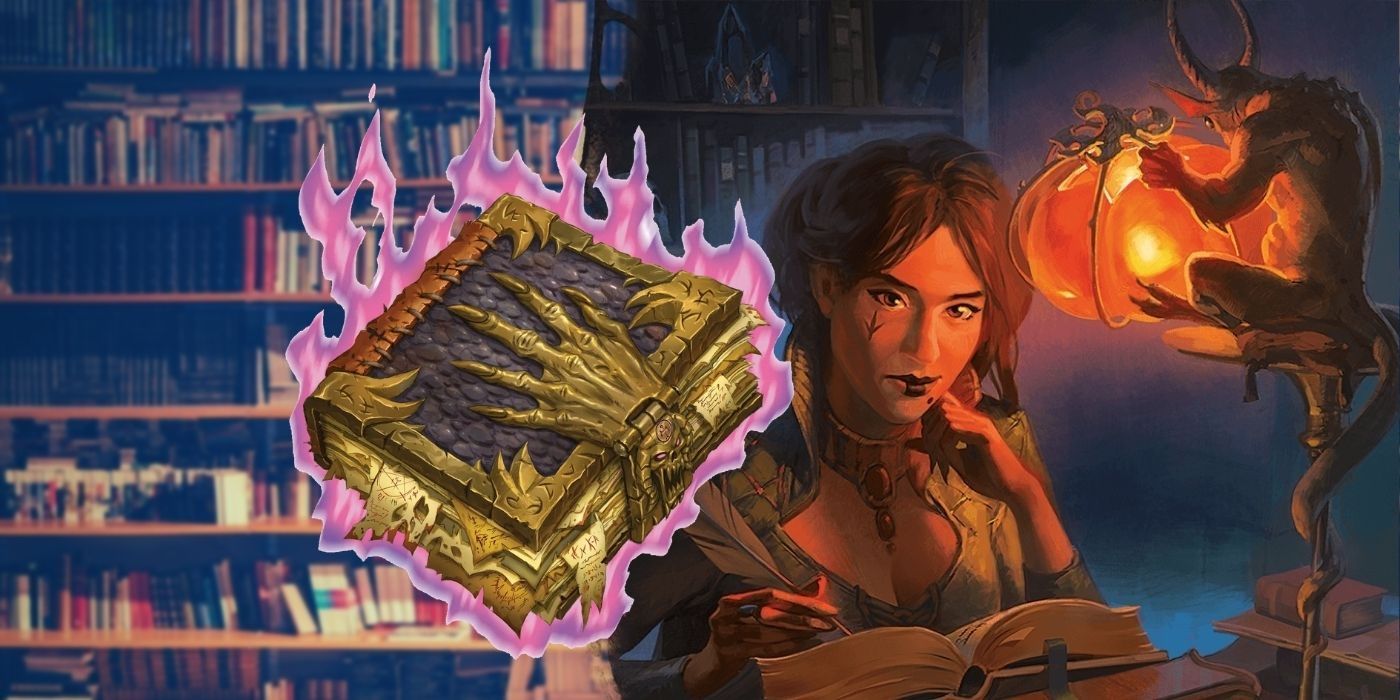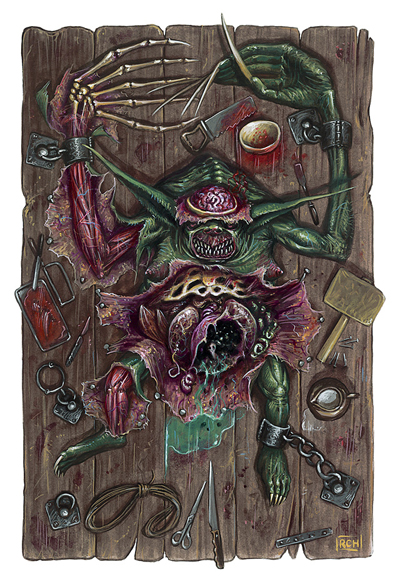The Abyss in Abholos 1
In the beginning, there was light . . . but in the time before that, chaos raged.To study fiends is to study the Abyss. Rage, hate, androiling chaos enshroud all ancient fiendish lore like a Darkmantle engulfs its prey. As such, students of demonic mythos are not usually claimed by madness, but by the subject matter itself. A lore master who tempts the Abyss with his curiosity might find it looking right back at him, hooking its shadowy tendrils into his soul and clutching at his very being with a strength that predates the eternal. But madness? No, he will not survive to know madness. That said, I study the lore of demons, and somehow I endure. I have neither wrestled the Abyss directly nor allowed my many encounters with the fiends that serve it (yes, I said they serve it!) to quench my thirst for knowledge. Those who come after me might be more careful, if less skilled, and they can continue the dark journey from the end of my steps. But, alone in my explorations, I have uncovered truths they could not hope to discover firsthand. Most importantly, I have learned that the Abyss is the darklink chaos from which all things come. This genesis has nothing to do with good or evil—just pure, churning chaos, in its simplest form. Who could have believed that the origin of life—of earth, of tree and stream—spawns from such turmoil? Yet, it is true. It is only through the imposition of order that the gods create, and they must work the stuff of chaos to build their thrones above man’s domain. They create law and force order, twisting what was pure into something . . . else—something more suited to their survival and their dominance over us. As such, they are not ultimately responsible for creation, but only for helping the essence of life take shape. Therefore, is it any wonder that demons hate and envy the divine? The gods corrupt the pure chaos of the fiends’ spawning grounds and leave them thrashing around in what is left. These deities then ascend to higher planes, often taking credit for the creation of the universe, or individual planes, or mankind, or any number of wonders over which they had little influence. The chaos and evil of the Abyss is all the fiends have left, which is why the demonic now wage war against the divine.It is my hope that I shall discover much more before I am myself overcome by the Abyss. However, the fiends have learned of my quest for knowledge, and they fear my power. Soon, the battle will come. I can only pray to gods I no longer worship that my learning survives me. Forge on.- Daitchi 'Dai' Yukisai, Loremaster of the Abyss
The Scrolls of Daitchi
When Daitchi Yukisai compiled his knowledge of fiends, he knew his work would attract the attention of his subjects, if not the Abyss itself. Dai believed that all life in the universe derives from the chaos of the Abyss, thus extrapolating that the Abyss itself must be alive as well. Still, even Dai never ascribed intelligence or sentience to the Abyss. He firmly alleged that nothing alive (or even undead) could comprehend the nature of the Abyss’s existence. However, he did posit a motive for it—a return to chaos. Dai deemed it possible that the intelligence of the demonic creatures spawned in the Abyss were, in fact, its own intelligence, working toward this goal. Through their ultimately chaotic efforts, he believed that the fi ends would bring about the Abyss’s desired outcome—the end of all things mortal and immortal, and a universe that could, once again, live wholly without order or purpose. Few lore masters have read even parts of the Scrolls
of Dai, and fewer still can understand what they have seen transcribed in Dai's spidery, wandering hand. While many of the Scrolls survived Dai's destruction (and the destruction of his entire kingdom, as well as a good deal of the landscape surrounding it), that devastating force scattered his writings to the four corners of the world, and beyond. Some say Dai's demonic assassins cursed his chronicles, ensuring that they would never again be collected in one place. Others who have read more than a few of the stained and torn parchments believe Dai's himself enchanted them, forcing them to move about the cosmos so the demons could not collect his work and destroy it. If any of the demon princes know the true answer to this question—and at least one must, for Dai's power grew as he worked, and no mere pit fiend or Marilith general could have overseen his demise—they refuse to speak it, even under dire compulsions. Again, some see this as Dai's handiwork, but none know for sure. As is true of many works of magical writing, transcribing all but the smallest and most innocuous parts of the Black Scrolls of Dai remains impossible. Still, the authors of this text have reproduced carefully selected excerpts in the hopes of passing on Dai's knowledge of fiends. But be warned. Should you come upon one of original scrolls in your thirst for knowledge, peruse it carefully, lest something out of the darkness come to devour you.
The Origins of the Abyss
The boundless Abyss and its countless layers spawn innumerable hordes of fiends, which shriek their hatred of all things until the tumult becomes unbearable. To describe a single demon cannot sum up the diversity of the species—if “species” is even the correct term. Chaos evokes variety, so demons cannot be easily described collectively. If Dai is correct, demons manifest as extensions of the chaos and evil left in the Abyss after the deities, devils, and other powers had “ascended” to other planes and begun forging their own domains, or occupying places created out of the chaos. Spawned directly from and by the forces of chaos, there are incalculable kinds of demons in the universe, and even Dai categorized the attributes of only a small percentage of them. In fact, the more this ancient scholar learned of individual demons, the more he despaired of ever quantifying their physiology. However, this escalation of data did allow him to recognize and establish a few of their commonalities. But why would there be commonalities at all? Aren’t demons spawned from chaos? Dai had a very logical explanation for why even the Abyss would abide by some vague sense of order. Demons derive from the very essence of their home plane, and the Abyss hungers for chaos and evil, using its creatures to bring more of the universe back to its ultimate starting point. For this purpose, Dai believed that the Abyss spawns even its most diverse demonic creations with the qualities most useful in spreading chaos and evil, as well as a burning desire to do so, thus creating a repetition of certain commonly found fiendish traits.
Still, even with this knowledge, demons will always remain somewhat mysterious and incomprehensible. Indeed, nothing about demons seems “natural” to a creature from the Material Plane, or most other planes, for that matter. To understand a manifestation of chaos and evil is to understand something beyond all frame of reference.
Since demons do not have a common ancestor, body type, or even the same needs for existence, they cannot be easily described in biological terms. Indeed, some scholars argue that demons possess no common traits beyond their origins. Dai disagreed. As stated previously, he believed that the Abyss shapes demons to perform certain tasks, necessitating that its creations conform in certain ways. Unfortunately, Dai presents little evidence on the subject. As you would expect, demons are notoriously difficult to study when alive, and when they die, their bodies either return immediately to the Abyss or decay very quickly. Nevertheless, chaos being chaos, some demonic corpses have inexplicably remained available for study.
All living Material Plane creatures share certain common elements. Humans, dragons, hippogriffs, mind flayers, and gnomes all eat. They all breathe. They all reproduce in some basic biological way. However, we do not share these traits with demons. Demons are not Material Plane creatures. As such, they do not have the same needs that we expect in other living creatures.
Eating: Demons do not need to eat. That said, a demon can consume endless quantities of food (of any sort), and they often take a particular joy in devouring sacrifices , especially gory or disgusting ones. Demons have even been known to consume tons of food in a single sitting, with no effect or consequence, leaving much debate about where the food actually goes. The most common theory is that their link to the Abyss somehow
transports the food back to their home plane, but no one has yet brought forward any proof of this.
Breathing: While they must breathe, demons have extremely strong lungs, built to withstand a range of environments, including the most deadly fumes of the Abyss, which would kill most Material Plane creatures. As such, demons can easily breathe in any natural Material Plane atmospheres.
Sleeping: Demons do not require sleep to function normally. However, powerful individuals occasionally do force them into sleep like states, and demons can even be rendered unconscious, though not easily. A demon can choose to fall asleep (which it would normally only do for deceitful purposes), but it gains no benefit from doing so.
Digestion: Even though demons can eat all the food they want, they do not have anything resembling biological digestion. The food seems to simply disappear after ingestion,unless the demon prefers to expel it somehow. If they choose, some demons can emit various kinds of discharges (such as vomit, ooze from pores, and other excretions), though not for any obvious purpose, other than the joy they take in polluting
their environment.
Reproduction: Some demons can reproduce if they choose (though not all of them have the necessary “equipment”), but it is not necessary for procreation, since new demons are formed directly from the chaos of the Abyss. Demons that can procreate usually do so only as a means to create half-fiends, though such creatures can be created in other ways (through arcane magic or curses).
Anatomy of a Dretch
The strange levels of strength in dretches for creatures of their small stature seemed to be at least partially magical, but also was a result of their cable-like muscles. This enhanced the power behind their raking claws, which were thin and as strong as steel. Their brains resembled those of natural creatures such as humans and other higher mammals, but were purple and exuded an indescribable stench.
Their abdomens were potentially the most bizarre part of their anatomy and filled with a harmless, if foul, black liquid that swirled around inside them and quickly enveloped the hands of those trying to handle it. Dretches had only a few discolored organs and despite eating most, if not all, organic matter presented to them, they lacked most digestive and excretory organs. Their only digestive system involved an esophagus connecting their mouths to what was presumably a stomach, perhaps indicating that they vomited what they couldn't digest or that the waste was simply oozed out through their pores.
Outside of the Abyss at least, a dretch's body swiftly decomposed upon death. Their tendons became pliable and easily severed while their bones could be snapped between someone's fingers. The liquid inside their chest evaporated leaving only a tarry residue, and the odor slowly faded away.
- Daitchi 'Dai' Yukisai, Loremaster of the Abyss, during a Lecture at a distant college.
Death
The topic of what happens to demons when they die is a cause for frequent debate. However, both the Demononicon and the Scrolls of Daitchi acknowledge that if a Demon dies inside of the Abyss, that they are brought back into the essence of the Abyss, and an extremely low chance on returning in a physical form. However, if the Demon is outside of the Abyss, then they'll return to the abyss soon after. They retain memories and appearance, though some may promote upon reincarnation. However, if they failed a mission, they could suffer a demotion. For Example, if a Nabassu had failed a mission, then it could suffer getting demoted to a Barlgura, Bulezau or even a Manes. Even Balors or Molydeus risk this at death for their Demon Lords. Only intervention from the Demon's Abyssal Lord can pardon the demotion or reincarnation. There is a difference though, whenever a Demon is summoned Magically, they will not gain the harm from dying, but instead reform in the Abyss unharmed. This has given all Magically summoned Demons an unrivaled, little amount of fear of death in their fiendish veins.
When a Balor dies, it explodes in a blinding flash of light and flame that consumes its corpse and sends whatever soul it possesses shrieking back to the Abyss. Few lesser demons die as spectacularly, but neither do they usually just fall to earth and rot. The following table includes suggestions of what might occur when a demon dies outside the Abyss.
| d20 | Effect |
| 1 | The corpse melts into a pool of black, tarlike ichor. |
| 2 | The head (or what remains of it) begins cursing in a dozen different languages and voices, after which the corpse simply winks out of existence. |
| 3 | Two snakes force their way out of the killing wound and begin devouring the corpse from either end. If attacked, the snakes disappear along with the remains. |
| 4 | The corpse crumbles to dust, leaving enough powdery remains to fill a small bag. |
| 5 | The flesh of the demon rots away (as if a hundred years pass by in an instant), leaving behind only a skeleton. |
| 6 | Half the demon’s body is engulfed in flame (harmless to nearby characters), while the other half freezes solid and falls to the ground, shattering. |
| 7 | A hole opens up in the fabric of the universe, and an unseen force sucks the demon into the hole with a loud “pop.” |
| 8 | The skin of the demon peels away, leaving its muscles and organs exposed. |
| 9 | All the bones and muscle tissue in the demon leak out its wounds in purple, smoking rivulets of blood. The remaining sac of skin bubbles quietly on the ground. |
| 10 | The body will discorporate into a foul-smelling mist. |
| 11 | Sparks and lightning burst around the killing wound, blackening the demon’s skin. In moments, the lightning consumes the corpse, leaving a smoldering spot on the ground. |
| 12 | The demon’s body immediately transforms into stone and shrinks down to the size of a tiny statuette. |
| 13 | Vermin explode out of the corpse, consuming it and then fleeing in all directions. |
| 14 | The demon turns translucent and then disappears in an explosive fl ash of light, leaving its shadow image on all nearby walls. |
| 15 | The demon’s skeleton tears itself free of its flesh, takes three steps, and then crumbles into dust. |
| 16 | Shadowy hands reach up from the floor and pull the corpse into the ground, leaving behind no sign of the demon. |
| 17 | As the demon falls, its corpse explodes into tiny, 1-inch-high duplicates of itself. The tiny demons immediately begin fighting among themselves until only one remains, which then vanishes in a puff of smoke. |
| 18 | Blinding, yellow light explodes out of the demon’s eyes and ears. Cracks appear in the creature’s skin as the light spreads, consuming the fiend’s body in harmless but spectacular energy. |
| 19 | The demon falls to the ground, and its flesh rots away in an instant, leaving behind a sickly odor. The bones remain, but they will turn to dust at the slightest pressure. |
| 20 | Nothing special. The demon expires as if it were a normal, Material Plane creature. |
As for the rest of the life cycle, demons do not grow old, and they do not die of anything remotely resembling natural causes. At best, they return to the unformed Abyss and their essence becomes part of the evil and chaos of the plane.






Comments
Author's Notes
Most of this Article was made with the Fiendish Codex I - Hordes of the Abyss book made by Ed Stark - https://en.wikipedia.org/wiki/Ed_Stark . I do not imply that I own any of the Fiendish Codex Work, but instead wish to shine light onto such a well made book, and bring it into 5e d&d